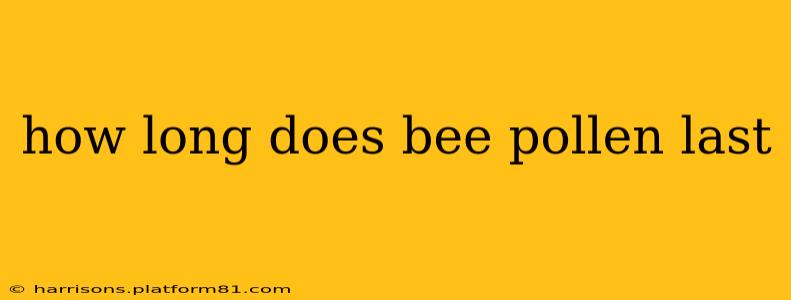Bee pollen, a nutritional powerhouse packed with vitamins, minerals, and antioxidants, is a popular dietary supplement. But how long does this beneficial substance retain its potency and quality? The answer, unfortunately, isn't a simple number of days or weeks. Several factors influence the shelf life of bee pollen, significantly impacting its nutritional value and potential health benefits.
What Affects the Shelf Life of Bee Pollen?
Several crucial elements determine how long your bee pollen remains viable:
-
Harvesting and Processing: The method used to harvest and process the pollen significantly impacts its longevity. Pollen harvested and processed carefully, with minimal exposure to heat and moisture, will last considerably longer than pollen subjected to harsh processing techniques.
-
Storage Conditions: This is arguably the most critical factor. Improper storage can drastically shorten the shelf life, even leading to spoilage.
-
Moisture Content: High moisture content promotes the growth of mold and bacteria, rapidly degrading the pollen's quality and rendering it unsafe for consumption. Low moisture content is key to preservation.
-
Temperature: High temperatures accelerate the degradation of nutrients and increase the risk of spoilage. Consistent cool temperatures are ideal.
-
Exposure to Light: Direct sunlight or exposure to strong artificial light can damage the pollen's delicate components, diminishing its nutritional value.
How Long Can You Expect Bee Pollen to Remain Usable?
While there’s no single definitive answer, here's a general guideline:
-
Properly Stored: Under ideal conditions (cool, dark, dry environment), bee pollen can retain most of its nutritional value for up to two years. However, some of its delicate components might degrade over time.
-
Improperly Stored: If stored in a warm, humid, or brightly lit environment, bee pollen may only last for a few months. It may become rancid, develop mold, or lose its beneficial properties much sooner.
How to Tell if Your Bee Pollen Has Gone Bad?
Several indicators suggest your bee pollen may no longer be suitable for consumption:
-
Changes in Odor or Appearance: A musty, sour, or otherwise unpleasant smell is a clear sign of spoilage. Similarly, significant changes in color, texture, or the appearance of mold indicate that the pollen has gone bad.
-
Changes in Taste: If the pollen tastes rancid or unusually bitter, it's best to discard it.
-
Presence of Mold: Visible mold growth is a definite indication that the pollen should be immediately discarded. Don't risk consuming moldy bee pollen.
Frequently Asked Questions (FAQ)
Can you freeze bee pollen to extend its shelf life?
Yes, freezing bee pollen is an excellent way to extend its shelf life. Freezing helps to slow down the degradation process and prevent the growth of mold and bacteria. Ideally, store it in an airtight container to prevent freezer burn.
Can bee pollen go bad if it's not refrigerated?
While not all bee pollen needs refrigeration, it's highly recommended. Storing bee pollen at room temperature significantly increases the risk of spoilage, particularly in warmer and more humid climates.
What are the signs that bee pollen is losing its potency?
While you can't always tell if the potency is diminished, changes in odor, taste, color, and texture, as well as visible mold, are all strong indicators of degradation.
How should I store bee pollen to maintain its quality?
Store bee pollen in an airtight container in a cool, dark, and dry place. Refrigeration or freezing is strongly recommended to maintain its quality and extend its shelf life.
By following these guidelines and paying attention to the condition of your bee pollen, you can ensure that you are consuming a product that is both safe and rich in its nutritional benefits. Remember, when in doubt, throw it out!
